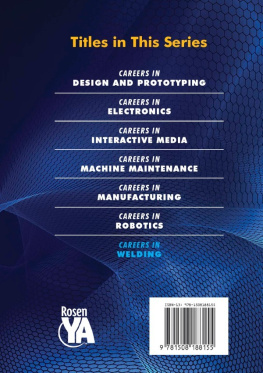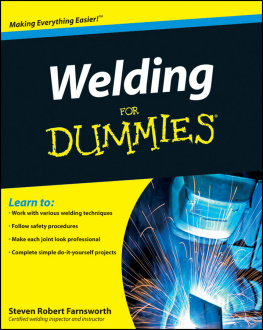Blondeau - Metallurgy and Mechanics of Welding
Here you can read online Blondeau - Metallurgy and Mechanics of Welding full text of the book (entire story) in english for free. Download pdf and epub, get meaning, cover and reviews about this ebook. City: London, year: 2010;2013, publisher: Wiley;ISTE Ltd, genre: Romance novel. Description of the work, (preface) as well as reviews are available. Best literature library LitArk.com created for fans of good reading and offers a wide selection of genres:
Romance novel
Science fiction
Adventure
Detective
Science
History
Home and family
Prose
Art
Politics
Computer
Non-fiction
Religion
Business
Children
Humor
Choose a favorite category and find really read worthwhile books. Enjoy immersion in the world of imagination, feel the emotions of the characters or learn something new for yourself, make an fascinating discovery.
- Book:Metallurgy and Mechanics of Welding
- Author:
- Publisher:Wiley;ISTE Ltd
- Genre:
- Year:2010;2013
- City:London
- Rating:4 / 5
- Favourites:Add to favourites
- Your mark:
- 80
- 1
- 2
- 3
- 4
- 5
Metallurgy and Mechanics of Welding: summary, description and annotation
We offer to read an annotation, description, summary or preface (depends on what the author of the book "Metallurgy and Mechanics of Welding" wrote himself). If you haven't found the necessary information about the book — write in the comments, we will try to find it.
Metallurgy and Mechanics of Welding — read online for free the complete book (whole text) full work
Below is the text of the book, divided by pages. System saving the place of the last page read, allows you to conveniently read the book "Metallurgy and Mechanics of Welding" online for free, without having to search again every time where you left off. Put a bookmark, and you can go to the page where you finished reading at any time.
Font size:
Interval:
Bookmark:

First published in France in 2001 by Hermes Science/Lavoisier in 2 volumes entitled Mtallurgie et mcanique du soudage and Procds et applications industrielles du soudage
First published in Great Britain and the United States in 2008 by ISTE Ltd and John Wiley & Sons, Inc.
Apart from any fair dealing for the purposes of research or private study, or criticism or review, as permitted under the Copyright, Designs and Patents Act 1988, this publication may only be reproduced, stored or transmitted, in any form or by any means, with the prior permission in writing of the publishers, or in the case of reprographic reproduction in accordance with the terms and licenses issued by the CLA. Enquiries concerning reproduction outside these terms should be sent to the publishers at the undermentioned address:
| ISTE Ltd 27-37 St Georges Road London SW19 4EU UK | John Wiley & Sons, Inc. 111 River Street Hoboken, NJ 07030 USA |
| www.iste.co.uk | www.wiley.com |
ISTE Ltd, 2008
LAVOISIER, 2001
The rights of Rgis Blondeau to be identified as the author of this work have been asserted by him in accordance with the Copyright, Designs and Patents Act 1988.
Library of Congress Cataloging-in-Publication Data
[Mtallurgie et mcanique du soudage English] Metallurgy and mechanics of welding: processes and industrial applications / Edited by Regis Blondeau.
p. cm.
Translation of Mtallurgie et mcanique du soudage and Procds et applications industrielles du soudage.
Includes bibliographical references and index.
ISBN 978-1-84821-038-7
1. Welding. I. Blondeau, Rgis. II. Title: Procds et applications industrielles du soudage.
TS227.M385 2008
671.5'2--dc22
2008027554
British Library Cataloguing-in-Publication Data
A CIP record for this book is available from the British Library
ISBN: 978-1-84821-038-7
What a long story welding is! Seeing the light of day at the end of the 19th century in the mind of scientists, it passed quickly into the hands of technicians, first of all with the oxyacetylene technique, then with arc welding and resistance welding techniques. Other processes (we will not quote them all in this introduction) then followed and the 20th century ended with laser welding which had its origins in the 1980s.
However, it must be said that only since the 1950s has welding been the main means of assembly, as riveting was the most used method up to that point.
In fact, after abandoning this method to some extent, scientists renewed their involvement in the 1930s. In France, at the time, Albert Portevin set out Les bases scientifiques de la soudure autogne and a higher education teaching programme began in 1931 at LInstitut de soudure. In the 1930s welding was implicated in bridge failures, notably in Germany and Belgium, then during World War II came the failure of Liberty ships constructed in great numbers thanks to the technique of welding. Other later catastrophic failures affected pressure vessels. It is in this context that in 1948 LInstitut international de la soudure (IIS/IIW) was founded. It met the need for international collaboration, in particular with regard to safety and research, expressed by different national bodies and by the whole welding world, from scientists to users. Today in 2008, the IIS/IIW holds its 61st annual meeting: 16 commissions, with sub-commissions and study groups, cover the whole field of welding, from design to performance and safety, including teaching and research. This demonstrates the importance of this collaboration and the richness of its contribution.
Welding can be regarded, like the language of Aesop, as the best and worst of things. Indeed, it makes it possible to bond almost all materials, from metals to plastics, with continuity; however, this does not imply homogenity. The processes and hence possibilities are very numerous depending on the types of assemblies to be made, the properties required and evident economic constraints to be respected. At the same time welding can be regarded as the weak link of the majority of constructions as it is often called into question when problems arise. In the examples cited above (bridges, Liberty ships, pressure vessels) it is the welding that is called into question each time often it must be added linked to a parent metal whose resistance to a sudden failure is insufficient.
The phenomena that occur during welding are both numerous and complex. In particular, the influence of extremely rapid thermal cycles and at high temperature on the physical, metallurgical and mechanical properties of welded materials always requires a better understanding.
In order to produce this work, the multiplicity of knowledge, scientific as well as technical, to be put in practice has led us to have recourse to a range of authors to share the task. The disadvantage is of course a certain disparity between the various chapters, as well as the risk of some repetitions. On the other hand, its richness is derived from this very fact as this work brings together the contributions of numerous French specialists well known in their specific field. It presents an entity as complete as possible on the knowledge available today on welding, without of course claiming to be exhaustive (for example, the welding of the plastics is outside its scope).
In a first part of 7 chapters, which deals with metallurgy and mechanics of welding, deals with the whole of the thermal, metallurgical and mechanical phenomena, which occur in the heat affected zone (HAZ) of the base material. Here the transformation phases with all the consequences they have on the structures and their properties are presented, as well as the phenomena of cracking, in particular cold cracking, which is a recurring theme of this work.
is similar but deals with the question of molten metal in the weld, with other phenomena of cracking that are called into play.
The different types of filler products are then dealt with in depending on the process used. The progress made in the manufacture of these products in order to improve the properties of the weld and resistance to cracking is explained.
illustrate the problems of failure in service of welded constructions, the former dealing with resistance to fatigue, with solutions suggested both for materials and for the execution of the welds, the latter dealing with brittle failure, with, after setting out the methods of evaluation of the toughness and the evolution of the harmfulness of defects, proposals relating to the composition of the parent material, the quality of the filler metal and the importance of welding conditions.
The second part, , focuses on the applications of welding for various materials and in various industries.
First of all, is devoted to the welding of thin sheets, both bare and coated, mainly used in the automotive market with the appropriate processes of welding. The importance of new steels with a very low percentage of carbon is underlined.
The subject of is the welding of steel mechanical components in the automotive industry, with less traditional processes calling upon a minimum of molten metal.
The welding of steel structures is the subject of . The steels used and the techniques of welding with the precautions required in order to avoid defects are presented.
concerns the welding of pressure vessels. It deals with examples of large components such as pressurized water reactors (PWRs) in the French nuclear industry and analyzes the various processes of welding and coatings used according to the parts of the vessel.
Font size:
Interval:
Bookmark:
Similar books «Metallurgy and Mechanics of Welding»
Look at similar books to Metallurgy and Mechanics of Welding. We have selected literature similar in name and meaning in the hope of providing readers with more options to find new, interesting, not yet read works.
Discussion, reviews of the book Metallurgy and Mechanics of Welding and just readers' own opinions. Leave your comments, write what you think about the work, its meaning or the main characters. Specify what exactly you liked and what you didn't like, and why you think so.








